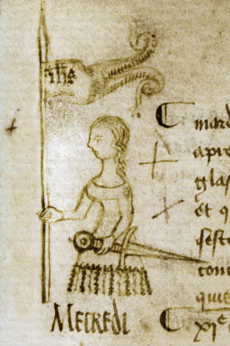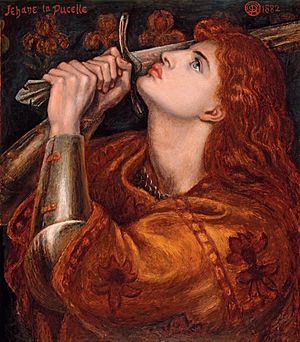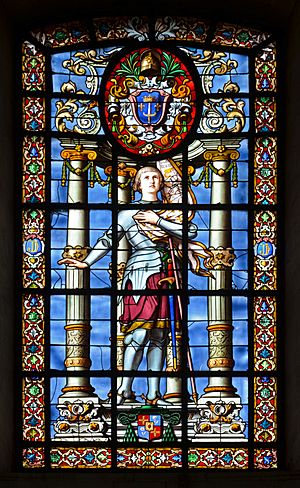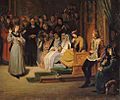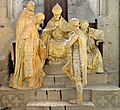Joan of Arc facts for kids
Quick facts for kids SaintJoan of Arc |
|
|---|---|
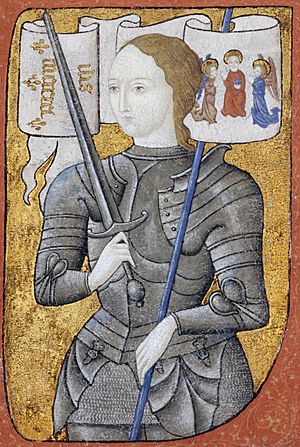
Historiated initial depicting Joan (dated to the second half of the 15th century, Archives Nationales, Paris, AE II 2490)
|
|
| Virgin | |
| Born | c. 1412 Domrémy, Duchy of Bar, Kingdom of France |
| Died | 30 May 1431 (aged c. 19) Rouen, Normandy (then under English rule) |
| Venerated in | |
| Beatified | 18 April 1909 by Pope Pius X |
| Canonized | 16 May 1920 by Pope Benedict XV |
| Feast | 30 May |
| Patronage | France |
Joan of Arc (born around 1412 – died 30 May 1431) was a brave young woman from France. She is often called "The Maid of Orléans." Joan is known for her important role during the Hundred Years' War, a long conflict between England and France. She is honored as a Roman Catholic saint and is one of the nine main patron saints of France.
Joan of Arc has been a popular figure in stories, paintings, and movies for centuries. Many famous artists and writers have created works about her life.
Contents
What Was Joan of Arc's Name?
Joan of Arc's name was written in many ways during her time. There was no standard spelling for her last name. It was often written as "Darc" without an apostrophe. Other spellings included "Tarc," "Dart," or "Day."
Joan did not learn to read or write when she was a child. She would tell others what to write in her letters. She later learned to sign her name, which she wrote as "Jehanne." In her letters, she called herself "Jeanne la Pucelle," which means "Joan the Maiden." Later, in the 1500s, people started calling her the "Maid of Orleans."
When and Where Was Joan of Arc Born?
Joan of Arc was born around 1412 in a small village called Domrémy. This village is in the northeast of France.
Her birth happened during the Hundred Years' War. This war started in 1337 because England and France disagreed over land and who should be the French king. Most of the fighting took place in France, which caused a lot of damage.
At the time Joan was born, France was divided. The French king, Charles VI, was often too sick to rule. His family members fought over who should control France. This led to a civil war within France itself.
In 1415, Henry V of England invaded France. The English and their French allies, the Burgundians, took control of much of northern France, including Paris. The French heir to the throne, Charles VII, was called the Dauphin. He was unable to be crowned king because the English and Burgundians controlled Reims, where French kings were traditionally crowned.
Joan of Arc's Early Life
As a young girl, Joan helped her family with farm work. She did chores around the house, spun wool, and looked after animals. Her mother taught her about religion.
Joan's village was loyal to the French side, even though it was surrounded by areas that supported the Burgundians (who were allied with England). The war affected her village. In 1425, Domrémy was attacked, and villagers felt that the English needed to be driven out of France for peace to return.
Joan's Visions and Prophecies
Joan later said that when she was about 13 years old, she began to have visions. She saw Saint Michael and other angels. She said these visions happened often, especially when church bells rang. Saint Michael was a patron saint of her area and was seen as a protector of France.
There were prophecies in France about a young woman who would come to save the country. One prophecy said a virgin carrying a banner would end France's suffering. Joan believed she was this promised maiden.
Meeting with Robert de Baudricourt
In 1428, Joan asked her uncle to take her to a nearby town called Vaucouleurs. She wanted to ask the military commander there, Robert de Baudricourt, for soldiers to take her to the French court. Baudricourt refused at first and sent her home.
In July 1428, Joan's village was attacked again, forcing her family to flee. She returned to Vaucouleurs in January 1429. This time, she gained support from some soldiers. She also met with Charles II, Duke of Lorraine, who was ill and hoped she might have special powers. Joan did not offer cures but spoke to him about his life.
The Siege of Orléans
At this time, the English had surrounded the city of Orléans. This city was very important because it was the last major obstacle before the English could attack the rest of the French territory. Joan's visions told her to leave Domrémy and help the Dauphin Charles.
In February 1429, Baudricourt finally agreed to let Joan go to the Dauphin. She traveled with six soldiers. Before leaving, Joan started wearing men's clothes, which she continued to wear for the rest of her life.
Joan of Arc's Military Campaigns
Joan of Arc met Charles VII at his court in Chinon in early 1429. She was 17, and he was 26. She told him she had come to end the siege of Orléans and to lead him to Reims to be crowned king. They had a private talk that greatly impressed Charles.
Charles VII sent Joan to the siege of Orléans as part of a mission to help the city. Joan quickly became famous after the siege was lifted just nine days later. She helped the French win several more quick battles. These victories allowed Charles VII to be crowned king at Reims. This event was very important for French morale and helped lead to France's final victory in the war. Charles rewarded Joan by making her a noble.
Capture, Trial, and Death
On 23 May 1430, Joan was captured near Compiègne by the Burgundians. This group of French nobles was allied with the English. She was then given to the English.
The English put her on trial. The bishop Pierre Cauchon, who supported the English, led the trial. Joan was accused of various charges. After the trial, she was found guilty. On 30 May 1431, Joan of Arc was burned at the stake. She was about 19 years old when she died.
Joan's Innocence Declared
In 1456, a new court, approved by Pope Callixtus III, looked into Joan's first trial. This court found that the charges against her were false. They declared her innocent and said she was a martyr, meaning she died for her beliefs.
In the 1500s, Joan became a symbol for the Catholic League. In 1803, Napoleon Bonaparte declared her a national symbol of France. She was officially recognized as a blessed person in 1909 and made a saint in 1920.
Joan of Arc's Legacy
For centuries after her death, Joan of Arc became a legendary figure. Most of what people knew about her came from old stories. However, in the 1800s, original documents from her trials were found. These included records from her condemnation trial and her rehabilitation trial. The rehabilitation trial had sworn statements from 115 witnesses.
Historians say that no other person from the Middle Ages has been studied as much as Joan of Arc. She came from a simple village and became famous as a teenager, even though she was an uneducated peasant.
Many women throughout history have seen Joan as a strong role model. She showed that an ordinary person could receive a special calling from God.
Modern Recognition
Several ships in the French Navy have been named after Joan of Arc. One was a helicopter carrier that stopped active service in 2010.
Joan of Arc is still a very important symbol in France today. There is a French national holiday in her honor on the second Sunday of May. Songs from World War I also mentioned her, like "Joan of Arc, They Are Calling You".
Patronage
Joan of Arc is a patron saint of:
- France
- Martyrs
- Captives
- Military personnel
- People who are made fun of for their strong faith
- Prisoners
- Soldiers
- Women who have served in the military
Images for kids
-
Joan's birthplace in Domrémy is now a museum. The village church where she attended Mass is to the right, behind the trees.
-
Detail of Joan of Arc, in front of Charls VII, responds to the prelates who question her by Gillot Saint-Evre (1832, Louvre)
-
The Coronation of Charles VII by Jules-Eugène Lenepveu with Joan attending (c. 1886–1890, Panthéon, Paris)
-
Mural Joan captured by the Burgundians at Compiègne by Jules-Eugène Lenepveu (c. 1886–1890 in the Panthéon, Paris)
-
Joan of Arc interrogated in prison by the Cardinal of Winchester, by Hippolyte Delaroche (1824, Musée des Beaux-Arts)
-
Joan of Arc's Death at the Stake, by Hermann Stilke (1843, Hermitage Museum)
-
Joan of Arc in armor, from the New Orleans copy of statue Jeanne d'Arc by Emmanuel Frémiet (original 1874, Place des Pyramides)
See also
 In Spanish: Juana de Arco para niños
In Spanish: Juana de Arco para niños



